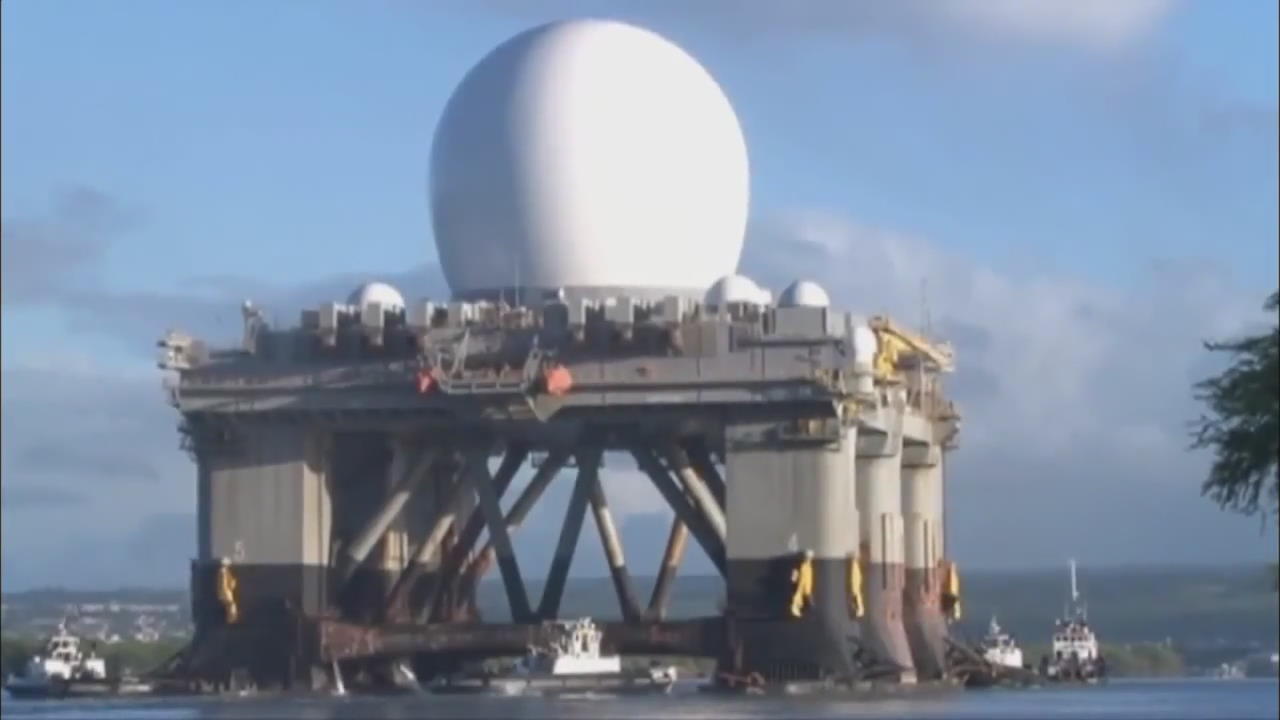U.S. Radar Deployment
입력 2017.01.13 (14:14)
수정 2017.01.13 (14:18)
읽어주기 기능은 크롬기반의
브라우저에서만 사용하실 수 있습니다.
[Anchor Lead]
The high-tech U.S. radar known as X-band, which is based at sea and can detect ballistic missiles in the air, has departed for Korea. Observers say that the deployment of the radar on the Korean Peninsula may represent Washington's preparations for intercepting North Korean long-range missiles.
[Pkg]
The sea-based X-band radar is equipped with a large radar dome on a deck the size of a soccer field. Its outstanding detection capabilities can detect even baseballs 2000 kilometers away. The radar is now on its way to Korea. Foreign media reported that the radar is moving to the northwest toward the Korean Peninsula, having departed from Hawaii on January 9. By the end of this month the radar is expected to approach the waters off Japan's east coast, just 1,600km away from the Korean Peninsula. The deployment of the radar represents Washington's first military response to North Korean leader Kim Jong-un's plan to fire intercontinental ballistic missiles, which he outlined in his New Year's address. Observers say that Washington may be preparing in earnest to intercept Pyongyang's missiles if the latter decides to put its plan into action. North Korean missiles detected by the X-band radar could be intercepted by SM-3 missiles launched from the U.S. Aegis destroyers.
[Soundbite] Ashton Carter(U.S. Sec. of Defense/Jan. 8)
The X-band radar has been relocated multiple times before to detect missiles when Pyongyang escalated its nuclear threat. Just three months ago it was utilized in the vicinity of the Korean Peninsula for a period of one month.
The high-tech U.S. radar known as X-band, which is based at sea and can detect ballistic missiles in the air, has departed for Korea. Observers say that the deployment of the radar on the Korean Peninsula may represent Washington's preparations for intercepting North Korean long-range missiles.
[Pkg]
The sea-based X-band radar is equipped with a large radar dome on a deck the size of a soccer field. Its outstanding detection capabilities can detect even baseballs 2000 kilometers away. The radar is now on its way to Korea. Foreign media reported that the radar is moving to the northwest toward the Korean Peninsula, having departed from Hawaii on January 9. By the end of this month the radar is expected to approach the waters off Japan's east coast, just 1,600km away from the Korean Peninsula. The deployment of the radar represents Washington's first military response to North Korean leader Kim Jong-un's plan to fire intercontinental ballistic missiles, which he outlined in his New Year's address. Observers say that Washington may be preparing in earnest to intercept Pyongyang's missiles if the latter decides to put its plan into action. North Korean missiles detected by the X-band radar could be intercepted by SM-3 missiles launched from the U.S. Aegis destroyers.
[Soundbite] Ashton Carter(U.S. Sec. of Defense/Jan. 8)
The X-band radar has been relocated multiple times before to detect missiles when Pyongyang escalated its nuclear threat. Just three months ago it was utilized in the vicinity of the Korean Peninsula for a period of one month.
■ 제보하기
▷ 카카오톡 : 'KBS제보' 검색, 채널 추가
▷ 전화 : 02-781-1234, 4444
▷ 이메일 : kbs1234@kbs.co.kr
▷ 유튜브, 네이버, 카카오에서도 KBS뉴스를 구독해주세요!
- U.S. Radar Deployment
-
- 입력 2017-01-13 14:11:59
- 수정2017-01-13 14:18:12

[Anchor Lead]
The high-tech U.S. radar known as X-band, which is based at sea and can detect ballistic missiles in the air, has departed for Korea. Observers say that the deployment of the radar on the Korean Peninsula may represent Washington's preparations for intercepting North Korean long-range missiles.
[Pkg]
The sea-based X-band radar is equipped with a large radar dome on a deck the size of a soccer field. Its outstanding detection capabilities can detect even baseballs 2000 kilometers away. The radar is now on its way to Korea. Foreign media reported that the radar is moving to the northwest toward the Korean Peninsula, having departed from Hawaii on January 9. By the end of this month the radar is expected to approach the waters off Japan's east coast, just 1,600km away from the Korean Peninsula. The deployment of the radar represents Washington's first military response to North Korean leader Kim Jong-un's plan to fire intercontinental ballistic missiles, which he outlined in his New Year's address. Observers say that Washington may be preparing in earnest to intercept Pyongyang's missiles if the latter decides to put its plan into action. North Korean missiles detected by the X-band radar could be intercepted by SM-3 missiles launched from the U.S. Aegis destroyers.
[Soundbite] Ashton Carter(U.S. Sec. of Defense/Jan. 8)
The X-band radar has been relocated multiple times before to detect missiles when Pyongyang escalated its nuclear threat. Just three months ago it was utilized in the vicinity of the Korean Peninsula for a period of one month.
The high-tech U.S. radar known as X-band, which is based at sea and can detect ballistic missiles in the air, has departed for Korea. Observers say that the deployment of the radar on the Korean Peninsula may represent Washington's preparations for intercepting North Korean long-range missiles.
[Pkg]
The sea-based X-band radar is equipped with a large radar dome on a deck the size of a soccer field. Its outstanding detection capabilities can detect even baseballs 2000 kilometers away. The radar is now on its way to Korea. Foreign media reported that the radar is moving to the northwest toward the Korean Peninsula, having departed from Hawaii on January 9. By the end of this month the radar is expected to approach the waters off Japan's east coast, just 1,600km away from the Korean Peninsula. The deployment of the radar represents Washington's first military response to North Korean leader Kim Jong-un's plan to fire intercontinental ballistic missiles, which he outlined in his New Year's address. Observers say that Washington may be preparing in earnest to intercept Pyongyang's missiles if the latter decides to put its plan into action. North Korean missiles detected by the X-band radar could be intercepted by SM-3 missiles launched from the U.S. Aegis destroyers.
[Soundbite] Ashton Carter(U.S. Sec. of Defense/Jan. 8)
The X-band radar has been relocated multiple times before to detect missiles when Pyongyang escalated its nuclear threat. Just three months ago it was utilized in the vicinity of the Korean Peninsula for a period of one month.
이 기사가 좋으셨다면
-
좋아요
0
-
응원해요
0
-
후속 원해요
0

















이 기사에 대한 의견을 남겨주세요.